|
|
|
Sort Order |
|
|
|
Items / Page
|
|
|
|
|
|
|
| Srl | Item |
| 1 |
ID:
120772
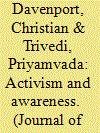

|
|
|
|
|
| Publication |
2013.
|
| Summary/Abstract |
There are a great number of outcomes for activism that are examined in the literature, but we know relatively little about how this behavior influences perceptions of the phenomena being challenged. It is possible that when one challenges some phenomenon, one begins to 'see' it more. Alternatively, activism might focus awareness on only certain manifestations of the problem of interest. The type of activism should matter here. We anticipate that only forms of resistance that increase exposure to oppression/oppressors and/or other challengers are likely to increase the number of discriminatory actions identified. Especially important here is nonviolent direct action because of the significant amount of training and interaction among activists that is facilitated by such activities as well as the extensive amount of exposure that nonviolence generally subjects participants to. Utilizing a unique database of 98,316 untouchables (or Dalits) from 1,589 rural villages in Gujarat, India, we find support for our argument. Specifically, Dalits who engaged in nonviolent action which increased either exposure to oppression/oppressors or exposure to other activists but not both, identified a higher number of discriminatory events. In short, some activism does activate some awareness. This has implications for dissident commitment, radicalization, and post-conflict political processes.
|
|
|
|
|
|
|
|
|
|
|
|
|
|
|
|
| 2 |
ID:
120774
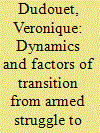

|
|
|
|
|
| Publication |
2013.
|
| Summary/Abstract |
The dynamics of conflict (de)escalation by social movements or political opposition groups have attracted cross-disciplinary interest among social scientists, but there remain several knowledge gaps to be filled. On the one hand, there is already extensive research on the shifts from unarmed expressions of collective grievances to the adoption of violent strategies by oppressed constituencies or 'minorities at risk', as well as on the transition from armed insurgency to negotiations, demobilization, reintegration and conventional politics. However, there is scarce scholarship on the phenomenon of armed groups shifting their conflict-waging strategies from violent to nonviolent means, especially in contexts which cannot be resolved by force but are also 'unripe' for conventional de-escalation methods through negotiation and political integration. This article offers a first attempt to fill this conceptual and empirical gap, by investigating the nature and the drivers of transitions from armed strategies to nonviolent methods of contentious collective action on the part of non-state conflict actors. It focuses in particular on the internal and relational/environmental factors which underpin their decisionmaking process, from a change of leadership and a pragmatic re-evaluation of the goals and means of insurgency, to the search for new local or international allies and the cross-border emulation or diffusion of new repertoires of action. This multilevel analysis draws from past research on various self-determination or revolutionary movements which fit the scope of analysis (i.e. Nepal, Egypt, Palestine, West Papua, East Timor, Mexico and Western Sahara). The article also points to the need for more systematic enquiry on these cases through in-depth comparative empirical analysis.
|
|
|
|
|
|
|
|
|
|
|
|
|
|
|
|
| 3 |
ID:
120773
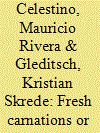

|
|
|
|
|
| Publication |
2013.
|
| Summary/Abstract |
Whereas optimists see the so-called Arab Spring as similar to the revolutions of 1989, and likely to bring about democratic rule, skeptics fear that protest bringing down dictators may simply give way to new dictatorships, as in the Iranian revolution. Existing research on transitions has largely neglected the role of protest and direct action in destabilizing autocracies and promoting democracy. We argue that protest and direct action can promote transitions in autocracies, and that the mode of direct action, that is, whether violent or nonviolent, has a major impact on the prospects for autocratic survival and democracy. We present empirical results supporting our claim that nonviolent protests substantially increase the likelihood of transitions to democracy, especially under favorable international environments, while violent direct action is less effective in undermining autocracies overall, and makes transitions to new autocracies relatively more likely.
|
|
|
|
|
|
|
|
|
|
|
|
|
|
|
|
| 4 |
ID:
120768


|
|
|
|
|
| Publication |
2013.
|
| Summary/Abstract |
This article explores those factors that shape a political organization's choice of tactics in political mobilization with a particular focus on the influence of gender ideology on the choice of different type of contentious action. To understand why political organizations engaging in contentious politics choose to employ violent tactics, nonviolent tactics, or a mixture of both, current scholarship has tended to focus on factors such as relationship with the government, external support, and religious or leftist ideology. Far less attention has been given to the role of an organization's ideology relating to gender when predicting its behavior. In addition, much of the analysis of contentious activity has analyzed the use of violence or protest separately and rarely examines the choice of a mixed strategy. We employ a time-series multinomial logistic regression analysis to examine the Middle East Minorities at Risk Organizational Behavior dataset (MAROB), including data over 24 years on 104 ethno-political organizations that have used a range of tactics including protest, violence, and/or a mix of the two, to investigate organizational and state-level variables that lead organizations to choose different strategies. We find that a number of variables can influence a movement's choice to engage in one strategy over another. Gender-inclusive ideology makes an organization more likely to engage in protest and less likely to choose a violent or mixed strategy.
|
|
|
|
|
|
|
|
|
|
|
|
|
|
|
|
| 5 |
ID:
120770
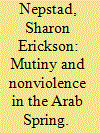

|
|
|
|
|
| Publication |
2013.
|
| Summary/Abstract |
Recent studies of civil resistance indicate that security force defections can heavily influence the outcome of nonviolent uprisings against authoritarian regimes. Yet we know little about why, when, and how mutiny occurs. In this article, I ask: what factors influence the likelihood of military defections during a nonviolent conflict? In reviewing various literatures, I identify ten factors that facilitate or obstruct mutiny. I propose that two of these are particularly influential: (1) whether troops receive economic or political benefits from the regime; and (2) whether troops perceive the regime as fragile, based on the international community's response to the conflict. Specifically, I argue that troops who receive benefits from a regime are more likely to remain loyal while those who receive no such benefits are more likely to defect. However, even the most underprivileged troops are unlikely to defect if they believe that the state is strong enough to withstand a major civilian uprising. Soldiers' perception of regime strength is partly shaped by whether outside nations support the opposition, thereby weakening the state, or send troops to reinforce the regime's control. Using a qualitative comparative method, I illustrate these dynamics through an examination of several Arab Spring uprisings: Egypt, where the military sided with civil resisters; Bahrain, where troops remained loyal to the state; and Syria, where the military split. Then, to encourage more research on this topic, I use these three cases to generate additional hypotheses about defections that others can test against a wider set of cases. I conclude with a discussion of the questions that future researchers should explore and the types of methodological approaches that are needed in this field of study.
|
|
|
|
|
|
|
|
|
|
|
|
|
|
|
|
| 6 |
ID:
120766
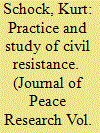

|
|
|
|
|
| Publication |
2013.
|
| Summary/Abstract |
This article provides an overview of the practice and study of civil resistance. First, historical roots of modern civil resistance are discussed, including the emergence in the 19th century of mass-based campaigns of non-cooperation to promote nationalist and labor interests, as well as the significance of Mohandas Gandhi and the widespread use of nonviolent resistance in the 20th century. Second, perspectives of scholars of social movements and revolution are compared with those of scholars who focus more specifically on nonviolent resistance. Despite studying much of the same phenomena, separate literatures have developed that are ripe for cross-fertilization and synthesis. In the third section, a literature review is organized around three key concepts for understanding civil resistance: mobilization, resilience, and leverage. Fourth, consequences of nonviolent resistance relative to violent resistance are discussed. Finally, areas for future research are identified.
|
|
|
|
|
|
|
|
|
|
|
|
|
|
|
|
| 7 |
ID:
120771


|
|
|
|
|
| Publication |
2013.
|
| Summary/Abstract |
Can local organizations give civilians the capacity to protect themselves from civil war violence? Civilians have traditionally been considered powerless when facing armed groups but new research suggests organized communities may promote security through nonviolent strategies such as resolving disputes between neighbors and managing relations with macro-armed actors. This article analyzes whether and how these 'mechanisms' designed to retain community autonomy functioned in the community-case of the Peasant Worker Association of the Carare River (ATCC) in Colombia. The Carare civilians developed a local institutional process to investigate threats against suspected armed group collaborators to clarify the 'fog of war' and reform civilian preferences to participate in the conflict. This process is evaluated in reference to existing hypotheses about violence in civil wars such as the balance of territorial control using qualitative evidence from original field research. A unique within-case database created through focus group sessions with community 'conciliators' is used to analyze not only acts of violence, but also threats that were defused. Despite the prevalence of conditions that would predict persistent violence against civilians, the local institution itself proved to be a critical factor for both explaining and limiting levels of violence. The results suggest civilian choices and their consequences did not merely result from the capabilities or choices of armed actors.
|
|
|
|
|
|
|
|
|
|
|
|
|
|
|
|
| 8 |
ID:
120769
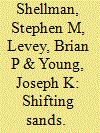

|
|
|
|
|
| Publication |
2013.
|
| Summary/Abstract |
Why does a dissident group go through phases of violence and nonviolence? Many studies of states and dissidents examine related issues by focusing on structural or rarely changing factors. In contrast, some more recent work focuses on dynamic interaction of participants. We suggest forecasting state-dissident interaction using insights from this dynamic approach while also incorporating structural factors. We explore this question by offering new data on the behavior of groups and governments collected using automated natural language processing techniques. These data provide information on who is doing what to whom at a directed-dyadic level. We also collected new data on the attitudes or sentiment of the masses using novel automated techniques. Since obtaining valid and reliable time-series public opinion data on mass attitudes towards a dissident group is extremely difficult, we have created automated sentiment data by scraping publicly available information written by members of the population and aggregating this information to create a pollof opinion at a discrete time period. We model the violence and nonviolence perpetrated by two groups: the Tamil Tigers in Sri Lanka and the Moro Islamic Liberation Front in the Philippines. We find encouraging results for predicting future phase shifts in violence when accounting for behaviors modeled with our data as opposed to models based solely on structural factors.
|
|
|
|
|
|
|
|
|
|
|
|
|
|
|
|
| 9 |
ID:
120765
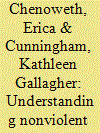

|
|
|
|
|
| Publication |
2013.
|
| Summary/Abstract |
The events of the Arab Spring of 2011 have made clear the importance and potential efficacy of nonviolent resistance, as well as the field's inability to explain the onset and outcome of major nonviolent uprisings. Until recently, conflict scholars have largely ignored nonviolent resistance. This issue features new theoretical and empirical explorations of the causes and consequences of nonviolent resistance, stressing the role that unarmed, organized civilians can play in shaping the course of conflicts. Contributors demonstrate the importance of treating nonviolent and violent strategies, as well as conventional politics strategies, as alternative choices for engaging the state, show how gender ideology can influence which opposition groups use nonviolent resistance, and suggest that the causes of civil war and nonviolent resistance often differ. Other pieces highlight the role of public attitudes regarding whether nonviolent resistance and violence are employed, how experience with activism and repression by the state can shape activists' perceptions of justice, and how the perceptions of resistance leaders can influence strategic choices. Moreover, several articles examine the key role that security force defections can play in the success of nonviolent resistance, how micro-level nonviolent tactics can improve security in civil war, and how nonviolent campaigns can influence the stability of autocratic states. These contributions suggest that rigorous empirical study of civilian-based contentious politics (rather than only violent contention by armed non-state actors) must be incorporated into the conflict literature. Improved theory and data on the subject will help researchers and policymakers to shape strategies to support these movements when appropriate, and to manage changes in the international system that result from the success of nonviolent uprisings.
|
|
|
|
|
|
|
|
|
|
|
|
|
|
|
|
| 10 |
ID:
120767
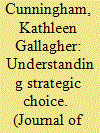

|
|
|
|
|
| Publication |
2013.
|
| Summary/Abstract |
What determines why some self-determination disputes develop into mass nonviolent campaigns, others turn into civil wars, and still others remain entirely in the realm of conventional politics? A great deal of work has addressed the factors that lead to violent mobilization, but less attention has been paid to understanding why disputes become violent or nonviolent, comparing these two as strategic choices relative to conventional politics. This article examines the determinants of strategy choice in self-determination disputes by analyzing how a variety of factors affect the costs and benefits of conventional political strategies, mass nonviolent campaign, and civil war. I find that civil war is more likely, as compared to conventional politics, when self-determination groups are larger, have kin in adjoining states, are excluded from political power, face economic discrimination, are internally fragmented, demand independence, and operate in states at lower levels of economic development. I find that nonviolent campaign is more likely, as compared to conventional politics, when groups are smaller, are less geographically concentrated, are excluded from political power, face economic discrimination, make independence demands, and operate in non-democracies. Examining the full set of strategies available to self-determination groups allows us to more accurately understand why these groups engage in mass nonviolent campaign and civil war.
|
|
|
|
|
|
|
|
|
|
|
|
|
|
|
|
| 11 |
ID:
120775
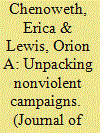

|
|
|
|
|
| Publication |
2013.
|
| Summary/Abstract |
Recent studies indicate that strategic nonviolent campaigns have been more successful over time in achieving their political objectives than violent insurgencies. But additional research has been limited by a lack of time-series data on nonviolent and violent campaigns, as well as a lack of more nuanced and detailed data on the attributes of the campaigns. In this article, we introduce the Nonviolent and Violent Campaigns and Outcomes (NAVCO) 2.0 dataset, which compiles annual data on 250 nonviolent and violent mass movements for regime change, anti-occupation, and secession from 1945 to 2006. NAVCO 2.0 also includes features of each campaign, such as participation size and diversity, the behavior of regime elites, repression and its effects on the campaign, support (or lack thereof) from external actors, and progress toward the campaign outcomes. After describing the data generation process and the dataset itself, we demonstrate why studying nonviolent resistance may yield novel insights for conflict scholars by replicating an influential study of civil war onset. This preliminary study reveals strikingly divergent findings regarding the systematic drivers of nonviolent campaign onset. Nonviolent campaign onset may be driven by separate - and in some cases, opposing - processes relative to violent campaigns. This finding underscores the value-added of the dataset, as well as the importance of evaluating methods of conflict within a unified research design.
|
|
|
|
|
|
|
|
|
|
|
|
|
|
|
|
|
|
|
|
|